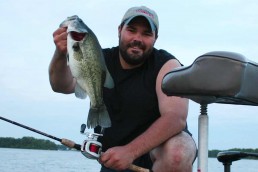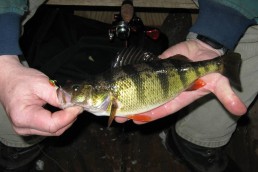Deep Water Bulls
SHARE THIS POST
Welcome to July! The peak of our summer season is kicking off with 4th of July celebrations, families hitting the road for much needed vacations, backyard cookouts and barbeques. Along with the peak of summer activity, our air and water temps are peaking as well.
With the spawn well behind us in most waters, fish are beginning their migration to depths more suitable for the warm-water months. When discussing these deeper water movements, many anglers believe these journeys into the deeper waters are limited to most of the popular gamefish such as bass, walleye, pike and muskies—just to name a few. But, for the focus of this month’s column, we will be directing our attention to the warmer-water patterns of bluegills.
A few followers of this column might be thinking, bluegills? Who can’t catch a bluegill? Other anglers consider bluegills kids’ or beginner’s species. I’ll agree that the mighty bluegill has entertained many newcomers to fishing, kids and adults alike. These fish, though rather small in stature, exhibit such tenacity and aggressiveness and such a willingness to bite, it’s quite understandable why these bantam game fish are a favorite for so many anglers.
Though I have battled the mighty bluegill since early childhood, I still consider these fish an exciting pursuit species. I’ll admit, there are those outings when my gear is chosen to target bluegills specifically. Proper gear for bluegills, or any species for that matter, is critical to finding success on the water.
Bluegills, for the most part, inhabit just about all waters found in the Midwest. It’s hard to fish the banks of most waters without seeing those summertime bluegills lining the shallow water banks and weedlines. But these adolescent ‘gills are not the focal point of this article. I’ll agree that if your intention is to introduce a new angler to the sport or keep up a kid’s interest, these shallower bluegills will certainly be willing to keep the action going strong.
For the sake of this article, we’ll be turning our focus from the smaller shoreline inhabitants, the typical 3- to 5-inch bluegills towards the big “bull” bluegills—you know—those fish in the 9- to 12-inch range, so big you can’t get your hands around them.
Large bluegills are rather elusive creatures. They frequent the shallows during the spawn, then for the remainder of the year retreat into the weeds or down into the depths. These fish are using cover and structure, similar to larger gamefish. Yet many anglers refuse to change their techniques or approach, and find themselves struggling to connect with these larger specimens.
The actual catching of these big bluegills never seems to be an issue, as they’re quite aggressive and will bite just about anything they can get into their mouths. It’s locating them that becomes a bit of a challenge.
Let’s take a look at a few warm water locations for these big ‘gills. Hopefully you can find similar locations on your favorite waters.
Where to look
My favorite hotspot for big ‘gills would be on a lake or pond with definitive weedline edges. These are very visible, as the weeds go from rather thick growth to a very distinct edge towards the middle of the lake. Often these outside edges are formed because there is a drop off with deeper water that doesn’t allow the weeds to reach the surface or the depth itself is deep enough not to support weed growth. Bottom types can also affect these lines when bottom make up doesn’t support particular types of weeds.
Are you enjoying this post?
You can be among the first to get the latest info on where to go, what to use and how to use it!
These weedlines will always be my first search area when fishing a body of water for big ‘gills. While your smaller ‘gills will inhabit the shallow or shoreline side of the weedline, your larger ‘gills will position themselves on the outside edges in or over deeper water.
Once the outside edge of the weedline is determined, the focus of your search needs to locate active bluegill vertically, rather than horizontally. Bluegills, like bass, will position themselves on the outside edges of the weedlines, and will move from shallow to deep depending on many variables, such as frontal systems, light conditions or forage movement. I’m not saying that bluegills won’t be on the move horizontally down the outside edges of the weedline—they will move that way as well—but in most cases, at least from my experience, the holding depth of these fish plays a bigger role in locating active fish.
Aside from the vertical positioning of ‘gills on the outside edge of the weeds, how far the fish hold themselves in proximity to the weeds can vary. While big ‘gills tend to school on the edges of the weeds, certain cold front situations or light penetration might cause these fish to actually bury themselves into the weedline, often with their heads facing the open water. Very similar to bass, bluegills will hold tight to cover during these tough cold front conditions.
While the weedlines are rather predictable for locating big ‘gills, other waters do have their share of big fish. Lakes or ponds with sparse weed growth will hold big bluegills as well. While on waters with sparse or very scattered weeds or weed clumps, set your focus on the thicker, denser weed growths, and those closest to the deepest water in the lake. These are much more run-and-gun situations, and to find active ‘gills, you must be willing to make many casts and be on the move.
Other types of water that contain surprisingly big ‘gills are the rather barren, dishpan type ponds or small lakes, many used as water retention areas. These can be tough waters to develop a pattern, as the obvious cover situations are lacking. Once again, the mobile angler will have the best opportunity to find these big ‘gills. Stay on the move and change your bait depths often, until active fish are located. If you can find any type of cover that is in deeper water, search these areas as well, as many of the larger ‘gills will relate to these objects.
Before we close, just a couple thoughts on rigs or bait choices. My tackle is very simple when on the move fishing for big bluegills, as I use a float and jig rig for most of my bull ‘gill hunting. I use sensitive Euro style floats—most all my floats are Thill Gold Medal floats in various sizes, depending on water conditions. I primarily use small jigs, most in the 1/32-ounce size, and keep the bodies or skirt materials in the 2-inch-or-less range. Body material is up to you, so you will need to experiment to find out what it is to which they’re responding. You can tip these jigs with live bait or scented plastics; once again, it’s personal preference. But following severe cold fronts, tipping the jig with a bit of live bait can boost your success.
Other baits can produce big ‘gills as well, such as small inline spinners, tiny ultra-light crankbaits, tiny swimbait plastics and other types of appropriate sized soft baits. Just remember, even though these bull ‘bluegills are often aggressive, they lack the overall mouth size to take in some baits.
Rods and reels, I use spinning only. I do prefer longer rods in that 8- to 13-foot range, but shorter rods will work as well. Reels of course match the rod size, but I fish rather large reels, as I can get more distance due to the larger spools.
With line, I pretty much stick with 2- to 8-pound test, but once again, line size depends on the water conditions and technique one chooses to use.
The season is now to tangle with some of these deep-water bull bluegills. Choose the appropriate tackle and focus on those fish off the shoreline. Big bluegills are a formidable gamefish, just in a smaller package. Hopefully, during the season, when the scent of brats and burgers fill the air, you’ll have an opportunity to spend a little time tangling with these “bulls” of the summer depths.
MWO
SHARE THIS POST
Did you enjoy this post?
You can be among the first to get the latest info on where to go, what to use and how to use it!
Dan Brozowski
Passion for angling drives Dan Brozowski to the water’s edge virtually any chance he gets. Although passion cannot be measured, weighed, or recorded, it can be shared. He does this through his writing and while on the water. If you have any questions or comments for Dan, you may contact him at: onthebank@att.net.



